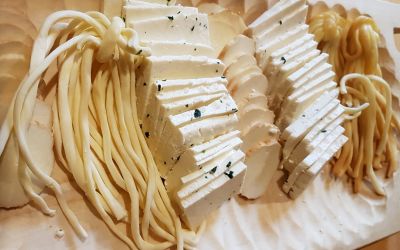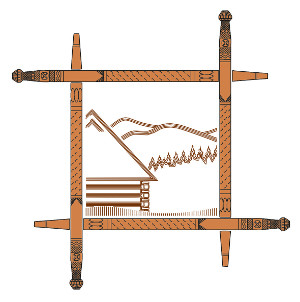
Shepherding is one of the oldest occupations, which the man has dealt with almost since the dawn of time. All holy books of various religions speak of shepherds, and a number of his works are referred to in parables. Sometimes pastoralism was the only or the main source of income for whole families and tribes, and with time, with the settlement of communities and the transition to agriculture, inseparably connected with the land, pastoralism began to play an accompanying and complementary role. To this day, there are still peoples for whom pastoralism is the main activity, allowing them to survive, especially on land that is not very fertile. What is more, in mountainous areas, there were not very good conditions for the development of agriculture, but there were good conditions for shepherds. The specificity of shepherding agriculture developed a peculiar profession and culture.
One of the basic works of the mountain pasture shepherds was milking the herd. The sheep were milked in the so-called "struncia" and the cows in the barracks or in the stables. Near each entrance to the "struncia" there were two shepherds sitting on stools. The milked sheep went to a large homestead and at that time the whipper-in was already rushing another one to the “struncia”. After milking, the shepherd brought all the milk to the stable, poured it to a 35-60 liter wooden vessel called "putyna". The summer puntyna was bigger and the autumn one was smaller (in Lemkivshchyna they reached 100 litres and were called putera or pustyna). The shepherd strained the milk through three strainers: the outer (braided of thick wool) middle (of loose canvas), and the lower one made of thick canvas. On the upper strainer he put a twig of fir, so that the milk would not splash while being poured. On the mountain pasture of sych products were made from sheep milk as lump cheese bundz (bundz, hrudka). Bryndza and wurda (urda, hurda) were made from such cheese. It is a cheese which is obtained after weighing the 'newarka'. - the whey, which remains after collecting the bundza. The milk was heated to the same temperature as the freshly milked one has and several tablespoonfuls of rennet (hleg, klak), prepared from a dried stomach of a young calf, lamb or goat were added to it. The most valuable was considered to be the rennet taken from the stomach of the goat. The rennet was stored in a specially prepared wooden vessel called 'klegowec' or 'klegowac' in the region of Bukowina Huculszczyzna the vessel was called 'hlegiwka'. In some parts of the Kosovo region in the 1930s, sheep's milk was treated with a special powder - pepsin, which was imported from the Netherlands and sold on the local market. The milk was mixed with the rennet and covered. After 15-20 minutes, the cheese was then whipped with a 'kołotewka'. Shepherd's whipped cheese was collected by hand, placed in a woollen or nettle strainer and hung on a dowel to drain the whey from it. Different types of cheese were made. For example, the following cheeses were distinguished in Rachowszczyzna: "kypriak' - the best with big pores, 'Mylak' or 'mylowowyj' of a lower quality, without pores, similar to soap, 'wistar' - well matured, 'soniczlywec', - of lower quality, which matured and dried out in the sun. The first time the cheese was collected, the whey called 'newarka' (dzer, dzera) remained. It was poured into a copper or iron container and brewed, stirred from time to time, so that it would not burn. When bubbles appeared on the surface, sweet milk was poured into the container and heating continued, stirring at the same time, to a temperature of 70-80 degrees. It was then taken from the fire and cooked again in about 25 minutes to obtain a thick wurda (urda, hurda). Afterwards, the wurda was collected with a large wooden spoon with holes and strained through a sieve. The best one was considered to be a wurda processed in a copper container.
The basic, traditional branch of the mountain pasture farm was the production of bryndza. The technology of its production was very simple and did not require complicated equipment. The whole process of bryndza production was called "bryndzyć bryndza" or " bryndza whipping". In the mountain pastures, bryndza was produced directly in stables. Well-acidified bundz was cut or broken into pieces with hands, thrown into putyna and salted. A four-sided dowel with jamming at the end of the bunk was shredded, shredding it into tiny particles. Shredded bundz was rubbed against the walls of the vessel and during a long process of grinding it was whipped into one mass. Then the bryndza was stirred in the opposite direction, adding salted pieces of wurda. They were thoroughly grinded, stirred with the whole mass, and stored in berbenyć (bryndzianka) or in barrels or wooden kneading-troughs (gelety), which were closed with a wooden cover. In some Hutsul villages, as early as in the 1870s, bryndza was stored in clean goat bellows (burdyha), where it was well-preserved for a long time. This method has been preserved in some regions of Romania. The method of preparing bryndza was the same in all mountain pastures. It was distinguished only by the proportions of bundza and wurda. In the Boyko region, the preparation of bryndza was described as: "there was bryndza" or "they made bryndza". The Boykos placed leaves of nettle or horseradish on top of the stored bryndza whereas nuts were put in the Zakarpacie. In the village of Jasień, they would pour butter over the bryndza. Such cheese was called "jidkyj" or "hurkey". Bryndza was also made from cow's milk. It was not as fat as sheep's milk, so in the Galician Boyko region it was called "light bryndza".
In autumn, when the sheep gave less milk, they were milked only twice a day and the morning and evening milk was acidified together (zhaniane mołoko).
Fresh cow's milk, in the mountain pastures, as well as at home, was used to prepare thick, soured milk - "huslianka". A distinction was made between raw huslianka prepared from raw milk and boiled from boiling milk. Fresh milk was brought to a boiling state, cooled and poured into a small container, where there was huslianka or sour cream. It was covered with a towel, with a lid on the top and wrapped in a sheepskin on cold days. After 10-12 hours the milk thickened. According to the second method, the boiled milk was poured into a clean vessel and a few tablespoons of huslianka or sour cream were added to it.
In the western Boyko region, especially in the Boyko-Lemko borderland, cow, steer and bull breeding dominated at the turn of the 19th and 20th centuries. As far as cows and sheep are concerned, cows of the so-called Pincgawska breed (red-dark grey, red-black) dominated in the western Zakarpacie region, which was characterized by a good external appearance and it did not have problems with grazing in the mountains. The northern side of the Carpathian Mountains was dominated by Hungarian steppe cows, the so-called sejki. As a result of work carried out since the nineteenth century, mixing local cows with alpine ones, a meat and milk breed breed, the so-called Carpathian one, was bred.
The basic type of sheep grazing in this area was the local breed of the so-called Wallachian, Wallachian sheep or zackel. In Zakarpacie it is called: raćka or Serbian sheep.
The rich shepherding and cheese-making traditions of the Carpathian Mountains are worth continuing and drawing on the centuries-old mountain culture of this magnificent land. This is particularly true of the Polish part of the mountains, in particular the Bieszczady Mountains and the Low Beskids, where today the broken tradition is slowly being revived, created by generations of different communities, for which the greatest value was the harmonious coexistence with these mountains and enjoying the benefits offered by the harsh but beautiful nature here.














